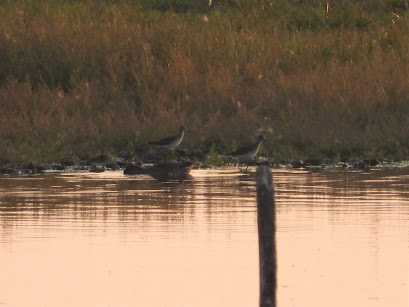It is exactly one week since the lockdown restrictions were eased to allow travel by car. Our dog walking was still based in the area around the home - we never use the car to transport the dogs to the popular sites - and I managed to see my first
house martin of the year on one such walk.
I took the opportunity to use the car to venture out further into the Sussex countryside to do some birding on my own. Two tried and trusted venues - the Ashdown Forest, only 15 minutes away by car, and the Knepp Estate, involving a longer drive of 45 minutes or so - were obvious starting points.
Ashdown Forest
Old Lodge NNR
I managed 3 trips to Old Lodge, looking for spring migrants.
- I had early success with redstarts, seeing a female on my first visit and a stunning male on my second. I was also delighted to find a couple on my patch at Churlwood later on in the week.
- tree pipits were in fine voice and present in good numbers. I witnessed one performing it's unmistakable song flight - the tree pipit rose a short distance up from the tree, and then parachuted down on stiff wings.
- woodlarks were prevalent.
- I heard the cuckoo several times but it was always a long way off so I couldn't get a sighting.
- willow warblers were singing out all over the reserve.
Nightjars
I made 6 successive visits to the forest around sunset to see if the nightjars had returned. In each case, despite the clear skies, there was no moonlight so visibility was poor once the sun had set. Venus was showing well though!
- the first 2 nights at Hindleap produced no nightjars but I did see at least 3 roding woodcocks.
- the next 2 nights I visited the Old Airstrip but there were no nightjars or woodcock there either. I had to settle for another cuckoo calling in the distance and a very vocal tree pipit.
- on Sunday night I heard a nightjar churring at Hindleap about 9.10 pm but I was unable to see it. I also called in at the old airstrip on the way home and heard a churring nightjar there too - but, again, no sighting.
- on Monday night things changed dramatically. I had a brilliant view of a nightjar at Hindleap - the bird flew right by me, less than 10 m away. A second bird was churring away in the distance so clearly we are starting to get an influx here.
- also on Monday night there were at least 3 churring nightjars at the Old Airstrip and I managed a very poor fleeting view of one of them.
The signs look very good for nightjars again!
I prefer to go to Hindleap where there is more chance of seeing woodcock but the Old Airstrip, with its more open aspect, offers easier viewing and it's possible to view till later.
The Knepp Estate
I made 2 early morning visits to the Knepp Estate, targeting turtle doves and nightingales. The weather conditions were superb with bright sunshine and very little wind.
This was truly an astonishing visit - the place was teeming with interesting birds.
- on at least 5 occasions I heard turtle doves purring away in the trees - the most I have ever encountered here. The only real disappointment was not being able to see any of them. Each time I was faced with tall bushes/vegetation preventing me from seeing into the nearby trees where the birds were.
- nightingales were singing all over the place with at least 5 territories encountered on my rounds - again the most I have ever had there.
- white storks were showing all around the site. The moment I will cherish most was seeing 6 of them flying above me. To see such magnificence here in the UK was mind boggling.
- whitethroats, lesser whitethroats, blackcaps, garden warblers etc, etc, were present.
- after 6+ attempts, I finally got to see a cuckoo and boy was it worth the wait! One was showing brilliantly in a tree just ahead of me and I watched it till it flew a hundred metres to the next tree where I watched it again.
This place just gets better and better.
I was so disappointed when our East Grinstead RSPB group conducted tour had to be cancelled due to the corona virus outbreak. This was a brilliant compensation.
Rodmell to Lewis Riverside Walk
I treated myself to an evening walk along the River Ouse from Rodmell (of Virginia Woolf fame) to Lewis to finish the first week of freedom.
The birding was nothing to write home about with lots of other people following this route but I did manage to add some new birds to my year list.
- reed warblers and sedge warblers were obvious additions.
- 4 common sandpipers flew past me on the outward journey and again on the return leg.
An unbelievable amount of birding this week with lots of migrants seen. Plenty of exercise too, with well over a marathon walked this week, maintaining my lockdown average.





























